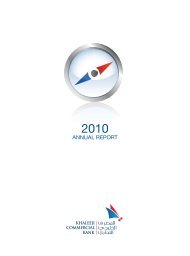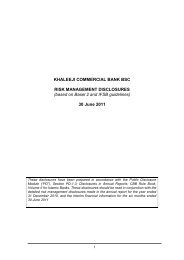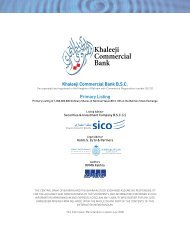2011 Annual Report - Khaleeji Commercial Bank BSC
2011 Annual Report - Khaleeji Commercial Bank BSC
2011 Annual Report - Khaleeji Commercial Bank BSC
Create successful ePaper yourself
Turn your PDF publications into a flip-book with our unique Google optimized e-Paper software.
KHALEEJI COMMERCIAL BANK <strong>BSC</strong><br />
NOTES TO THE CONSOLIDATED FINANCIAL STATEMENTS<br />
for the year ended 31 December <strong>2011</strong><br />
21. CRITICAL ACCOUNTING ESTIMATES AND JUDGEMENTS IN APPLYING ACCOUNTING POLICIES (continued)<br />
Fair value of unquoted equity securities (continued)<br />
Significant judgment is required to be made by the Group and the Board of Directors in the selection of an approach that<br />
would reflect the best measure of fair value of the investments. The choice of the models used for valuation on each reporting<br />
period may have a significant impact on the fair value of investments and the amounts reported in the consolidated financial<br />
statements. The <strong>Bank</strong> has adopted the market approach for valuation of its unquoted equity security.<br />
The potential effect of using reasonable possible alternative assumptions for valuing the investments resulting in 5% decrease /<br />
increase in the market multiple would increase / decrease the reported fair value by BD 873 thousands. The corresponding<br />
impact would be on the profit or loss reported by the Group.<br />
Impairment of financing assets<br />
Financing assets are evaluated for impairment on a basis described in accounting policy, refer to note 2 (l). Each counterparty<br />
exposure is evaluated individually for impairment and is based upon management’s best estimate of the present value of<br />
the cash flows that are expected to be received. In estimating these cash flows, management makes judgements about<br />
a counterparty’s financial situation and the net realisable value of any underlying assets / collaterals. Each impaired asset<br />
is assessed on its merits, and the workout strategy and estimate of cash flows considered recoverable are independently<br />
evaluated by the Risk Management Department.<br />
For evaluation of the portfolio for impairment on a collective basis, management, where available, uses estimates based on<br />
historical loss experience for assets and loss experience in the industry for assets with credit risk characteristics and objective<br />
evidence of impairment similar to those in the portfolio. For the purposes of a collective evaluation of impairment, financing<br />
assets are grouped on the basis of similar credit risk characteristics (that is, on the basis of the Group’s grading process<br />
that considers asset type, industry, geographical location, collateral type, past-due status and other relevant factors). The<br />
methodology and assumptions used for the grading process and estimating both the amount and timing of future cash flows are<br />
reviewed regularly to reduce any differences between loss estimates and actual loss experience. In view of the management,<br />
the current level of provisioning is adequate and no additional impairment allowances are required on a collective basis.<br />
22. ASSETS UNDER MANAGEMENT<br />
The <strong>Bank</strong> provides corporate administration, investment management and advisory services to its investment entities, which<br />
involve the Group making decisions on behalf of such entities. Assets that are held in such capacity are not included in these<br />
consolidated financial statements. At the statement of financial position date, the Group had assets under management of<br />
BD 384.83 million (2010: BD 427.93 million). During the year, the <strong>Bank</strong> has charged management fees amounting to BD 618<br />
thousands (2010: BD 1,260 thousands) for the management of these assets.<br />
23. RELATED PARTY TRANSACTIONS<br />
Parties are considered to be related if one party has the ability to control the other party or exercise significant influence over<br />
the other party in making financial and operating decisions. Related parties include the significant shareholders and entities<br />
over which the <strong>Bank</strong> and the shareholders exercises significant influence, directors and executive management of the <strong>Bank</strong>.<br />
A significant portion of the <strong>Bank</strong>’s income from investment banking services and management fees arises from entities (assets<br />
under management) over which the <strong>Bank</strong> or its significant shareholders exercises influence. Although these entities are<br />
considered related parties, the <strong>Bank</strong> administers and manages these entities on behalf of its clients, who are by and large third<br />
parties and are the economic beneficiaries of the underlying investments.<br />
Details of Directors’ interests in the <strong>Bank</strong>’s ordinary shares as at the end of the year were :<br />
Categories* number of Shares Number of Directors<br />
Less than 1% 8,358,250 5<br />
1% up to 10% 17,611,955 1<br />
* Expressed as a percentage of total outstanding shares of the <strong>Bank</strong>.<br />
Consolidated Financial Statements<br />
53










